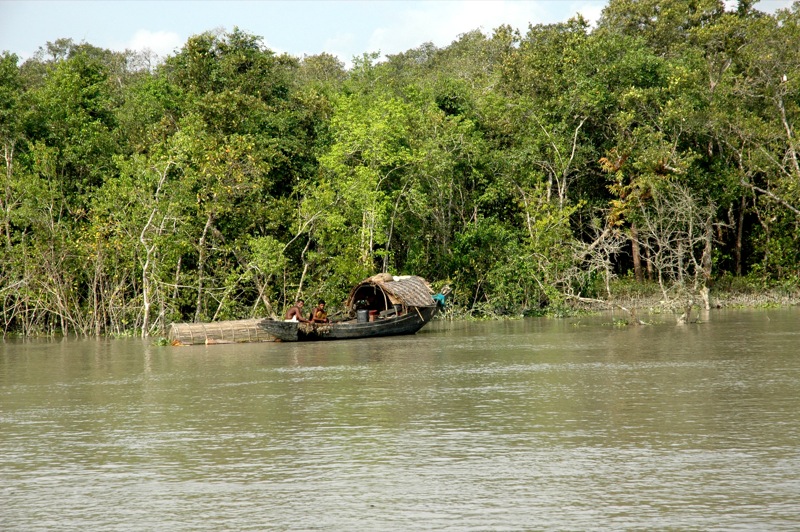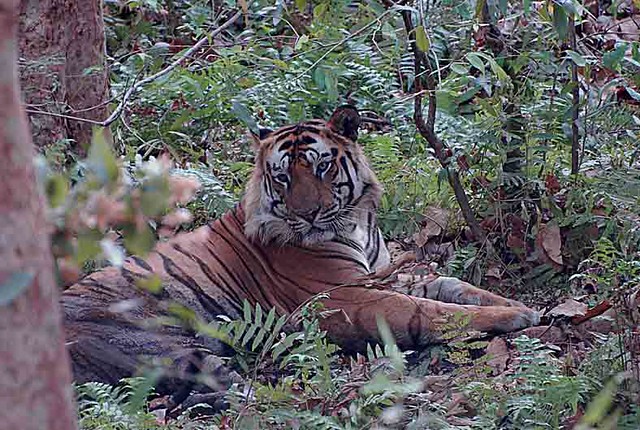The river’s channels are spread across the land like a fine-mesh net, creating a terrain where the boundaries between land and water are always mutating, always unpredictable. Some of these channels are mighty waterways, so wide across that one shore is invisible from the other, others are no more than two or three kilometres long… when these channels meet, it is often in clusters of four, five or six; at these confluences, the water stretches to the far edge of the landscape and the forest dwindles into a distant rumour of land.” — Amitav Ghosh in The Hungry Tide
For the teeming millions who go about their daily grind in the urban jungle that is Kolkata, it is hard to imagine that the fate of the Royal Bengal tiger is being decided just a hundred kilometres away. A local train ride away are the world’s most ancient mangrove forests, where man and beast have lived in uneasy proximity for centuries, in a constant state of war with the elements and each other. The outsider feels as if he is a trespasser, an insignificant presence at the very edge of the world.
Indeed, nothing prepares the outsider for the dramatic change in surroundings as he steps off an inevitably crowded local train at Canning Station. But a short auto ride later, he is standing at Sonakhali, a promontory overlooking a greyish river dotted with sundry watercraft. Most of these are country boats fitted with a hand-cranked diesel motor, which ferry passengers to and fro from Basanti on the other side of the river in a matter of minutes. The larger craft go downriver towards Gosaba, from where one might proceed in stages to the other river islands, and ultimately to the mohona or the confluence, the place where the waters of the river meet. The trip downriver is poignant and unforgettable.
By day, traffic on the river is busy, as commuter-heavy boats crisscross the waters. You might see a boatload of uniformed school children returning to their village or a boisterous wedding party dressed in all their finery. But as the light fades over the waters of the Gomor and then the Gumdi, you begin to feel and smell a vastness that laps at the edge of your senses. Occasionally, there are phantom craft moored on the riverbank, lit by the pinprick of a kerosene lamp. As your eyes get used to the darkness, it is possible to see tiny fishing boats still out on the water, observing an infinitely patient vigil to trap the bounty of the rivers. Life is not easy in the Sunderbans, especially for the humans. Traditionally, the locals have lived off the river as well as the forest, by trapping, felling, hunting and collecting honey and wax as the common sources of subsistence. But these activities have been practically banned after the Tiger Reserve was set up in 1978, though there are some who still manage to evade the eyes of the Forest Department officers. On the other hand, some have found occupation in the handful of tourist camps that have recently come up on some of the islands. Happily, most of these tourist camps support low-impact tourism, something absolutely essential given the fragile ecosystem of the Sunderbans. Which is what makes the recent attempts by the Sahara group to build a gigantic tourist complex in the Sunderbans — with proposed floatels, catamarans and helicopters — such an abomination.
One of the first things that the tourist to Sunderbans must appreciate is that it is not a zoo. The tiger will not come obediently to the wire-mesh netting and pose for the camera. By the last count, in 2004, there were 274 tigers in the area that stretches over almost 1,500 sq km. Before the netting was put up about a couple of years ago, the tiger was known to slip into the waters and come calling on its biped neighbours across the river. This would usually happen during the breeding period from November to February, when the mother is on the lookout for food for the cubs. Sometimes the tiger would carry away a goat or a cow — when it was less lucky, it would be cornered by irate villagers and stoned or speared to death. There is now more awareness about the need to conserve tigers and a beast that strays into human habitation nowadays has a better chance of ending up with a tranquilliser dart than a bullet.
The second thing to appreciate is the rich diversity of flora and fauna even if the tiger remains elusive. Cruising along the sanctuary is a non-stop lesson in biology. At the edge of the water, kingfishers, herons, egrets, sandpipers, whimbrels and plovers pinwheel through the air or wade daintily through the sand. What looks like a piece of dead wood suddenly turns out to be an alligator when viewed through binoculars. A deer pauses, mid-graze, and turns to look at a passing boat. A water monitor (or tarkel, as it is locally called) worries a drifting carcass by the shore. A shoal of dolphin surfaces tantalisingly and then vanishes in the eddying, churning waters of the mohona. And the mangrove forests themselves are absolutely unique — clumps of small, leathery, gnarled trees with names like sundari, hetal and gorjon. The riverbank is pierced by legions of breathing roots — the pneumatophores — like shapes out of a Van Gogh painting. If you are observant, you might also spot clumps of hetal bushes, much beloved of tigers, and appropriately called tiger bush. When you actually get off the boats at the tiger observatory camps, you can see the even smaller holes made by the eternally busy tiny red fiddler crabs.
About the Sundarban Tiger Reserve
The Sunderban Tiger Reserve, created in 1973, was part of the then 24-Parganas Forest Division. Subsequently, the area comprising the present Tiger Reserve was constituted as a Reserve Forest in 1978, incorporating some 2,585 sq km of the huge mangrove swamp, which extends for about 260 km from the Bay of Bengal to the Meghna River Estuary in Bangladesh. The total area of the Indian Sunderbans is in fact as large as 9,630 sq km, of which 4,263 sq km is forested. The Tiger Reserve itself is divided into two sectors, core and non-core, the former comprising 1,330 sq km and the latter 1,225 sq km. An area of 124.4 sq km within the core area is preserved as a zone to act as a gene pool. The Sajnekhali Wildlife Sanctuary was created in 1976, covering an area of 362.3 sq km. In 1985, the National Park area of the reserve was included in the list of World Heritage Sites and the entire Sunderbans area was declared a Biosphere Reserve in 1989.
The origin of the name Sunderbans is debated, but in all probability it gets its name from the sundari trees (Heriteria fomes) typical of the region. There are 64 plant species in the Sunderbans suited to survive in estuarine conditions and saline inundation that occurs as a result of tidal effects.
The Sunderbans is one of the world’s largest and most unique wetlands. Every 12 hours, high tide inundates the mangroves spread along either side of the network of water channels here. At low tide, you will see expanses of exposed mud ‘flats’.
Quick Facts
State: West Bengal
Location: Sundarban Tiger Reserve is the largest single tract of a unique mangrove ecosystem in the world, and spreads over 26,000 sq km. It forms the lower part of the Ganges Delta, extending about 260 km along the Bay of Bengal, from the Hooghly River Estuary in India to the Meghna River Estuary in Bangladesh. About 9,630 sq km of the ecosystem falls in India, and the Reserve Forest sprawls across 4,263 km of this expanse. About 60 per cent of the total area of the ecosystem falls in Bangladesh Distances 112 km from Kolkata, 24 km from Basanti Route from Kolkata State highway to Baruipur via Rajpur; district road to Basanti/ Sonakhali via Canning; motorboat to Sajnekhali WLS/ Sunderbans Tiger Reserve
When to go; The park is open all the year round, but it’s best from Sep-Mar Best sightings are from Oct-Feb Go there for Royal Bengal tigers, Irrawaddy dolphins, mangroves
About the Author
Abhijit Gupta has been teaching English at Jadavpur University, Kolkata, for the past seven years. He is co-editor of a series called Print Areas: Book History in India. He has been writing for Outlook Traveller since his plane caught fire over Riga, Latvia, in 2003






